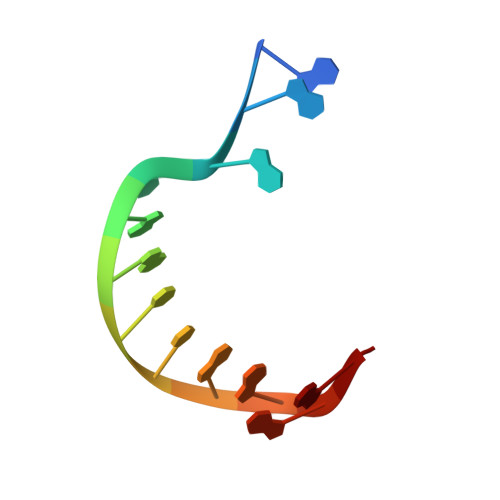Probing the role of sequence in the assembly of three-dimensional DNA crystals.
Saoji, M., Zhang, D., Paukstelis, P.J.(2015) Biopolymers 103: 618-626
- PubMed: 26015367
- DOI: https://doi.org/10.1002/bip.22688
- Primary Citation of Related Structures:
4RNK, 4RO4, 4RO7, 4RO8, 4ROG, 4ROK, 4RON, 4ROO, 4ROY, 4ROZ, 4RP0, 4RP1, 4RP2 - PubMed Abstract:
DNA is a widely used biopolymer for the construction of nanometer-scale objects due to its programmability and structural predictability. One long-standing goal of the DNA nanotechnology field has been the construction of three-dimensional DNA crystals. We previously determined the X-ray crystal structure of a DNA 13-mer that forms a continuously hydrogen bonded three-dimensional lattice through Watson-Crick and non-canonical base pairs. Our current study sets out to understand how the sequence of the Watson-Crick duplex region influences crystallization of this 13-mer. We screened all possible self-complementary sequences in the hexameric duplex region and found 21 oligonucleotides that crystallized. Sequence analysis showed that one specific Watson-Crick pair influenced the crystallization propensity and the speed of crystal self-assembly. We determined X-ray crystal structures for 13 of these oligonucleotides and found sequence-specific structural changes that suggests that this base pair may serve as a structural anchor during crystal assembly. Finally, we explored the crystal self-assembly and nucleation process. Solution studies indicated that these oligonucleotides do not form base pairs in the absence of cations, but that the addition of divalent cations leads to rapid self-assembly to higher molecular weight complexes. We further demonstrate that crystals grown from mixtures of two different oligonucleotide sequences contain both oligonucleotides. These results suggest that crystal self-assembly is nucleated by the formation of the Watson-Crick duplexes initiated by a simple chemical trigger. This study provides new insight into the role of sequence for the assembly of periodic DNA structures.
- Department of Chemistry & Biochemistry, University of Maryland, College Park, MD, 20742.
Organizational Affiliation:

















